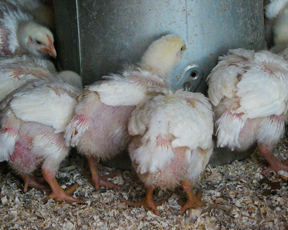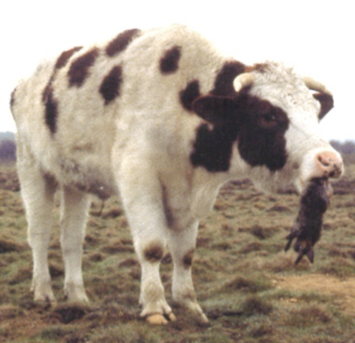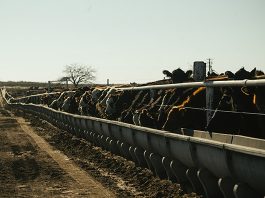
A few years back I was speaking at the Pennsylvania Assocation for Sustainable Agriculture’s annual conference. I took the opportunity on my off hours to attend a presentation about raising meat birds because it’s something I’ve always wanted to do. I started out completely optimistic, but as I jotted down the speaker’s numbers for feed costs, paying someone to process them, and then how much the finished birds sold for, I got depressed. It was clear that this was not a profitable venture at the scale I could do it.
But somewhere along the way, I forgot that lesson, or I thought, “I can cut costs, and process the birds myself, and they will be so tasty! And I have 3 acres that should be producing SOMETHING!” So my friend Leah and I said, “Sure, we can do that! It will be fun!”
So here is the story of the “fun” we had, and how much it cost us to eat our home raised chickens in the first year of our experiment.
March 2011

X@&K! PULLETS!
We buy 20 fast grow meat chicks. Seven weeks later, when they should have been almost full-grown and ready for harvest, we figure out why they haven’t gotten to harvest weight. We were given the wrong birds. They’re pullets. (Your garden variety egg-laying chicken.) We load them in the cat carrier, take them back and start again. Yes, we do feel stupid for being so slow on the uptake. But, if you don’t know what you’re doing….well, you don’t know what to expect.
How do we know our second batch is really fast growers? A friend picks one up to cuddle it and it shoots a long stream of golden poop down her lace shirt. At first we thought the golden coating of something smelly all over the bottom of their pen was a result of them spilling their water. No, we learned that it was their poop and it only got worse by the day.
Stench

About the time they are the size of softballs they get all sweaty like teenage boys and they stink just like them too… that’s not true, I’ve been in middle schools, they smell better than meat birds since they’re not also covered with a constantly growing layer of “poop.” All these birds do is eat, drink, grow and poop. Additionally, sometimes we’d go to check on them and one would just be belly up dead. There’s this thing that happens called “flip-over disease” which seems to happen when they eat too much and grow too fast and then they seizure, flip over and die. It’s awesome.
Housing

We raise the young birds inside with a heat lamp so they stay warm until they get their feathers. The first year we built our first chicken tractor to move them into when they got big enough. It probably cost us about $150 to build and a lot of time and brain power (to make it light enough for two women to move around). About the same time, we realized the local bear was scoping out the neighbor’s chickens. We thought there was enough other “easy” things for the bear to eat, so we put pavers around the bottom of our chicken tractor (to keep the small predators out) and called it good.
Butchering

Killing chickens is physically, emotionally, and financially draining. We sang “Goodbye chicken, goodbye chicken, goodbye chicken, it’s time for you to die” to our first victim to soothe all of us. Then we tied it’s legs together, slipped it head first into the killing cone (made from a $5 Home Depot bucket and some duct tape – classy!), and let it “rest” there before slitting it’s throat when it was finally calm. Then we walked off to let it calm down again (or die in peace) while it thrashed around in the cone. This was all done in view of the road and the neighbors, who knew enough to stay away from girls with knives.
Meanwhile, our not inexpensive turkey fryer, which has never yet been used to fry a turkey, is heating up a big pot of water. When the chicken was truly dead, we chopped off it’s head and dropped it in the blood collection bucket just below the killing cone. To pluck a chicken you have to dunk it in 200 degree water for about 15 seconds to loosen the feathers up. This enhances their natural aroma. Then you plop them on top of the plastic covered grill (the sideburner makes a great plucking table when closed) and yank out all the feathers. The big tail and wing feathers are the hardest to pull and the little fine feathers are the most tedious to finish off. If you’re fast, this takes 10 minutes. We were not fast the first year.
THEN you use the burner for the turkey fryer to singe off all the fine hairs and feathers you were unable to pull out. This smells AWESOME! (if you like the smell of burning hair, feathers and flesh). Now, drop the body in a cooler full of $5 worth of ice and water to let it cool before gutting.Don’t take a break or you’ll never get this done. So while it’s cooling, go grab a chicken, sing to it, let it calm, slit its throat, let it drain, cut off its head, dunk it, pluck it and singe it. It’s good to have multiple people to keep the assembly line moving.
Now to gutting. We plop the chicken on the plastic-covered picnic table and cut off its neck and feet. Actually, cutting off the feet is the most fun part of this whole process – don’t ask me why – it just is. Now, cut a horizontal incision between the bird’s back legs, and then carefully cut out the butthole. If you’re not careful, you’ll have poop everywhere. Even though we cooled the chicken, it’s still warm on the inside, which you notice when you stick your hand inside the bird and then gently pull out all the insides. We thought it was a little spooky when sometimes the chicken would cluck as we pulled out the insides. This is because we were pushing air through the yet-to-be-removed Cluck Box which is in the windpipe.
Now the chicken looks like what you would buy in the store (if you’d been smart enough to buy them in the first place). We are very proud of ourselves and manage to get 7 done in one day. Then we cleaned up the bloody plastic, the disgusting turkey fryer, and the killing cone and blood buckets, and ourselves. Our hands always smell like weird, dead, teenage chickens after a day of slaughter.
Predators

We butchered our first 7 chickens on a Monday and left the rest for the following Friday. Tuesday it looked like something had been prowling around the chicken tractor, and something had even reached in and nabbed a chicken, so we threw an old trellis on the roof and added extra bricks around the bottom. Wednesday morning, all was fine. Wednesday afternoon, it looked like a glimpse of the apocalypse had happened in our back yard. It appeared a bomb had exploded the chicken coop; the roof was ripped off, there was blood and chicken carcasses all over, and there were very scared, traumatized chickens left in the pen. We moved the remaining chickens up to the hen house with our egg layers. While in the process of calling the Division of Wildlife, the very happy bear returned to check out the murder scene. We chased it off and promptly put an electric fence around the chicken tractor. We left a dead chicken inside the pen to encourage the bear to come back and test the fence. I checked the fence at 11:00 p.m. when I heard a scream. It was a scary walk, but I was glad to see that the fence was still up, and the bear had probably learned about electricity.
Then we slaughtered the remaining 9 birds and decided it would be a really good idea to raise another batch of birds later that summer… Did we mention the bear was not trapped? Or that we had not totaled up the cost of each bird? We were inexperienced and optimistic.
Batch 2

We bought another 25 birds, fortified the chicken tractor with sheets of galvanized metal roofing, beefed up the electric fence, lost some birds to flip over disease, and went through the whole process all over again. We even sold a couple chickens to some friends for the high price of $15 each. Our freezers were stocked for the winter and we felt very successful.
Hindsight (is only 20-20 if you look)
Cost of chicks – $2.35 each from the store = $105.75
Cost of feed – $105
Cost of the chicken tractor- approx $120
Cost of repairs and renovation of the chicken tractor $40
Cost of materials for slaughter (year 1)- approx $100
Labor for raising chickens, building the chicken tractor, putting up fence, repairing the tractor, and slaughtering 2 batches of birds, all at the $7.78 Colorado minimum wage – $933.60

Grand Total = $1404.35
Cost per bird – about $40
We ate like queens (who didn’t do the math until much later).
Of course, amortized over several years, the cost of some of the infrastructure would also be spread over more product, reducing the cost. Still, this is all something to consider when creating your own poultry enterprise. Think about the scale you need to achieve to cover costs and make a profit.




Too funny (or not). It reminds me of our chicken raising experience only we didn’t key into fact our birds were fast-growing until our layers walked by their pen and we noticed they were waaaaay bigger than our full grown hens. When we finally got around to butchering them (we did have a turkey roaster, but opted to use the 9 quart enamel canner and put it on the propane base for our turkey roaster to heat the water) they weighed between 7 and 9 pounds. My husband, who loves fried chicken, couldn’t figure out why it took two fry pans to cook one of these birds. After that we smartened up and just roasted them. Yes. Delicious. For the two of us, one chicken made a week’s worth of meals, with soup being the grand finale. Since we were raising them only for ourselves, our batch of 25 minus the “flip-over” will end up lasting us about two years. I hear the “voice of reason” in all of the other blog responses, but your post sounds too much like real life to me. And oh, instead of building a movable chicken coop, we opted to cheap it out with an old stock tank and rolled it around every few days. I enjoyed your post thoroughly. Made me smile.
Thanks, Nancy! The next year, we moved the birds into a hoop house we built from 6x6x6 wire, chicken wire, 2x4s and a tarp to give shade. It was awesome, UNTIL the bear decided that 23 chicken nuggets (the chicks were 2 weeks old at the time) were worth the shock of the electric fence. He ate all but 2, which I moved in with the egg layers. Though I’d put them in their own area of the pen in a little fence, one escaped and drowned itself that same day. I think he just couldn’t live with the horror he’d seen. Since the remaining one had been through such trauma, we decided she could live until it was clear that it was time. She was the size of a small turkey with the most amazing layer of fat I’ve ever seen on a chicken. We served 6 people and ate the leftovers for a week.
Every year we tried, we learned something new. There are all these things that farmers just take for granted and that they never tell anyone, or that they just assume will be clear. And then there are events, like bears, or huge blizzards that last for 3 weeks. So every time we solved a problem, we encountered a new one the next year. And since we weren’t butchering all that many, we never got very fast at the whole pluck and gut thing. We checked out mechanical pluckers, but the building or buying of one looked like a larger investment than we thought we could afford, and there were no farmers in town to borrow one from.
All in all, it was a great learning opportunity, the meat was great, and….I appreciate folks who raise chickens!
So true everything you said about agriculture. If it’s not bears, it’s something else. May all your bear-eaten chickens rest in peace, and especially the one that got the pleasure of an extended life until it reached the dinner table. Good luck with all your other ag enterprises and may you be blessed with chickens raised by someone else.
You can avoid “flip-over” disease by only feeding your chicks what they should eat in a day instead of free-feeding. This also cuts down on vermin. If you are moving your pastured poultry on a twice daily basis, sprinkle the feed on the ground prior to moving the coop to that spot. It will teach your birds to move forward and to forage in the grass and dirt.
Save yourself a lil’ time, trouble and stank, and just skin those puppies!! It’s quicker and way less stanky!!
I am not sure why the chicks are stinking, and covered in poo, unless you are not cleaning their box and giving them fresh shavings, daily. Of course, it’s added labor and expense, but it’s a lot more sanitary and less stressful for the chicks as well.
Whatever you do, don’t get ducks…they are the messiest creatures on earth, next to pigs.
Comments are closed.